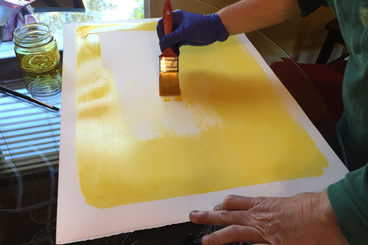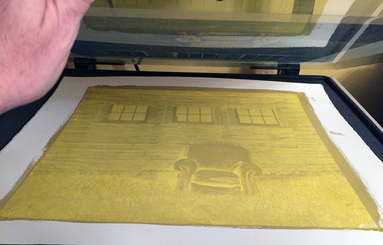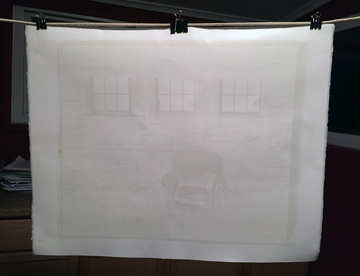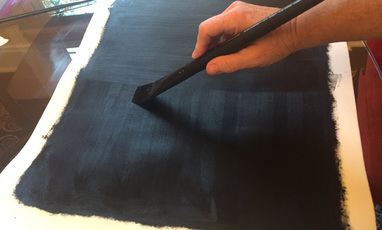Terri Cappucci
|
A good place to start... This is a little tip for beginners who have been wanting to try the gumoil process but have not been able to make a print. With this process being so temperamental, I have been continuing my search for materials that will lend itself to a more stable experience when trying to print for the first time. This is usually what will make people give up. I have found a pretty good paper and paint combination for beginners, with a less expensive professional grade paint that works great. Here is an example of making a small print using Arches Oil paper and Grumbacher Pre tested professional oil paint (Ivory Black). The paper is made to absorb the oil and seems to make a decent print. Not sure I will use this as my paper of choice for all my work, but I will be using it for my students. I thought I would share for those looking to begin this challenging process. With this said, there are many other fantastic papers and paints out there to explore when you begin to see what your needs and wants are, after you develop a comfortable workflow. Terri
0 Comments
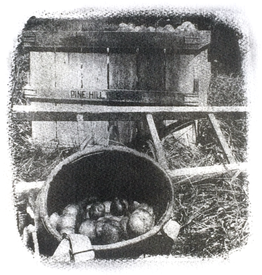 Here area few questions that I can answer for those who have asked about making gumoil prints.
What kind of paper? Make sure the paper you are using is a heavy and quality watercolor paper that can handle multiple passes through this process. I had been using a 310gsm paper but have now found that the 640gsm paper that I have been using, is much better for this process and gives me more flexibility with paints. You can use either hot or cold press, depending on your preference. Some brands I have experimented with success. Somerset – Stonehenge – Hahnemühle - Arches Platine - Indigo Art Paper ( the 640gsm paper is best for this) and Arches Oil paper. What brand of oil paint? This is not easy to answer. I know what has worked for me, but I can’t be sure it will work for you because again, my theory and experience has showed me it is different depending on your water source and atmosphere Grumbacher pre-tested - Maimeri Classico – Lukas - Old Holland – Schmincke – Williamsburg. It is best to use professional grade paint because the lower grades rarely make you want to try again. I have had trouble removing the paint when using lower grade paint. What kind of gum Arabic? That is really up to you. If you know how to mix your own, that is an option. I find that Windsor Newton has a nice premix that works well for me. I have also used Photographers Formulary, which is also a premix. “The Gumoil Process in not for those who seek instant gratification. You have to pour you passion, time and emotions into creating the workflow. This is when your dance begins”. Terri Cappucci 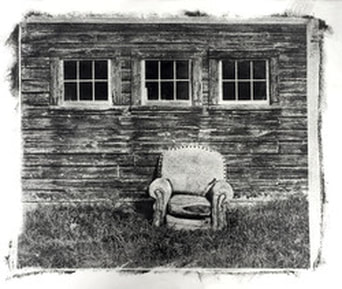 "Old Chair" (gumoil) Terri Cappucci "Old Chair" (gumoil) Terri Cappucci The Gumoil Process What is the Gumoil process? It is a photographic printing process that uses a sensitizing gum arabic mix and oil paint, to create a handmade photograph. It is more detailed than this, but it is a start when explaining to someone for the first time. I enjoy this tactile process known as Gumoil, for a few reasons. In the age of technology, photographs have become so easy to come by and are very uniform. They are either in a digital format on a screen, or the photographer has the ability of making multiple prints on a home printer. It is so easy for anyone with a camera to have unlimited photographs printed. Unless a particular process is involved, they are all done the same way and none are unique to each other. In my own photographic work, I find that I want and need something different. If I do not have my hands involved in the process, it will not feel like my creation. From the lens to the final print, my hands need to be as involved as my vision. With that said, I do work with digital on occasion, but I am really a film and alternative process photographer. Gumoil is very challenging and can frustrate from time to time, but that is the part that makes the results personal to me. The outcome will never be the same in any two prints. It makes the work one of a kind and each print, unique. After seeing some of my recent prints, Anna Ostanina (a fellow artist who was instrumental in my learning this process) said to me, “Terri, you have your own handwriting style in this process”. Those words really summed up what I had been looking for explain what I wanted to express in my art. I want my work to have my own thumbprint in and on it. A little history that I found online about the gumoil process. It was invented by Karl P. Koenig (1938-2012), in 1990. He originally called it “ Polychromatic Gumoil Photography”. Since this time, other photographic artists have taken his process and continued to explore, leading to multiple workflows and methods to get similar and even better, results. Koenig tends to remove his paint with more of a rubbing process. His book “Gumoil Photographic Printing” is no longer available, but it can be found used. I also came across Anna Ostanina’s work. She removes the paint with less rubbing and more water. It appeared easy when I saw her images and videos, but after speaking with and learning from her, it was not that easy. She had researched and tested the right combinations of paint, paper and steps, that would give her the paint removal process and final print results that she was seeking. She is a master of her craft and a gracious teacher. When I make my gumoil prints, I am using a combination of workflows that I learned from both Karl Koeing and Anna Ostanina. With that in mind, my supplies and mixtures may be different. Here is a list of what you need along with the image you want to use: *** Please be cautious using Potassium Dichromate. Do not inhale or get on your skin. Always wear gloves and a respirator face mask when working with this chemical. ***
Once dried, I take the paper out and put the inter-positive that I made of my image, on top of the now dried, sensitized area. I then expose it to the UV light. Exposure times will vary depending on the suns strength if you do it outside, or the kind of exposure unit you are using. I use a Nuarc exposure unit and exposure time is between 3-4 minutes. After being exposed, you will see the details of your image. As soon as it done exposing, soak the paper in water immediately. This is the developing process. This will stop the exposure and remove the rest of the yellow sensitizer. I soak for 15-30 minutes. This is a delicate part of the process as the gum swells on the paper and needs to be left to dry without being wiped or touched. It holds the part of your image with details and can remove or distort your image if it is wiped off while still wet. Take the print out of the water and dry your image. I use a drying rack I made or just hand on a clothes line. If you dry outside, be careful with wind. I have had little particles and bugs that have stuck to the gum. Once the print is completely dry, apply the oil paint. I don’t apply it thick because it is messy when it comes off. If you do add too much paint, try to smooth it out with a soft cloth or a quality paper towel. I use Viva paper towels because they don’t leave a lot of “fuzz” behind. The shadow areas will begin to show through the oil paint. This is when the print can be placed in water and gently removed with a sponge. Be gentle or you can wipe off the image, take off too much paint or damage the paper. There is another part of this process called “etching” where a bleach and water mix will allow a 10-15 second etch bath and then repeat the process of soaking, drying, applying paint and rinse and remove paint with a. soft sponge again. I don’t always etch my prints, but I will if I want to more detail in my image. A few things I have learned that have made a big difference in the success of my gumoil workflow. When I get the results I am pleased with, it will be in part because of a combination of water source, paint brand and quality and the water color paper being used. Sometimes there is a different combination of paint brands and paper that work, depending where I am. I have found that in my studio, one combination of paper and paint will work better with the water. If I am in a different location, I may have completely different results and have to use a different paint and paper combination. I am not sure why, but my theory is that it has to do with the water treatment in different cities and the water reaction to the entire mix of sensitizer and paint, depending on the location where the print is being created. Other gumoil artists may do things differently. After talking with others who make gumoil prints and trying many different techniques, papers, paints, exposure times, and steps, I have developed a workflow that gives me as close as I can get to having consistent results. With that in mind, it can change very quickly because this is still an unstable process. With that said, I am seeing more consistency with the new mix of paper and paint that I have been using. Here are a few videos I have made of my process:
Christopher James book “Alternative Photographic Processes” is another resource that offers some information on this process. So many artists that inspire me and I learn from…..Thank you all. *Acknowledgement: Karl Koeing, Anna Ostanina, Diana Bloomfield, Kelly Wrage, Daniel Zilbersheid, Quinn Jacobson, Laurie White Updated: February 19, 2018 |
Thoughts in Print"If you don't want something seen, control how much exposure you give it." tc categories |
Web Hosting tecapp media works
 RSS Feed
RSS Feed 